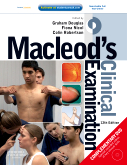|
|
|
| |
 |
|
|

|
 推薦指數:
推薦指數:





|
|
- 內容介紹
|
Macleod's Clinical Examination, 12th Edition
With STUDENT CONSULT Access
By Graham Douglas, BSc(Hons), MB, ChB, FRCPE, Fiona Nicol, BSc(Hons), MB, BS, FRCGP, FRCPE and Colin Robertson, BA(Hons), MB, ChB, FRCPE, FRCS(Ed)
The 12th Edition of this famous medical textbook, which was 'Highly Commended' in the 2006 British Medical Association Medical Book Competition, builds on the extensively rewritten previous edition. Over 500 clinical photographs and diagrams now illustrate the text, whilst new topics have been added to make the book even more comprehensive. A complementary DVD now accompanies the book, with specially-recorded videos demonstrating many of the clinical examination routines as they are described in the main text. The book is written by a team of editors and contributors who are all active clinicians and experts in their specialist fields, including in general practice where much of clinical teaching is now based. It describes the practical skills which every clinician must acquire and develop in order to evolve diagnostic procedures and management strategies and plans.
Section 1: History taking and general examination
Key Features
This text provides a clear description of the fundamental skills of patient evaluation and examination, answering the cunning questions which arise from this.
Starts with a general overview section on history taking and the general examination that provide the framework on which to hang the detail.
The systematic examination section documents clearly the relevant history, examination and special investigations as well as giving advice on their significance.
The final section covers specialised areas and emphasises an integrated and structured approach to these patients.
Closely linked to its sister publication, Davidsonâ?™s Principles & Practice of Medicine, which complements the information in this text.
Available with full online access on Student Consult and with a DVD of specially-recorded videos demonstrating key clinical examination routines following the format laid out in the book.
|
|
|

